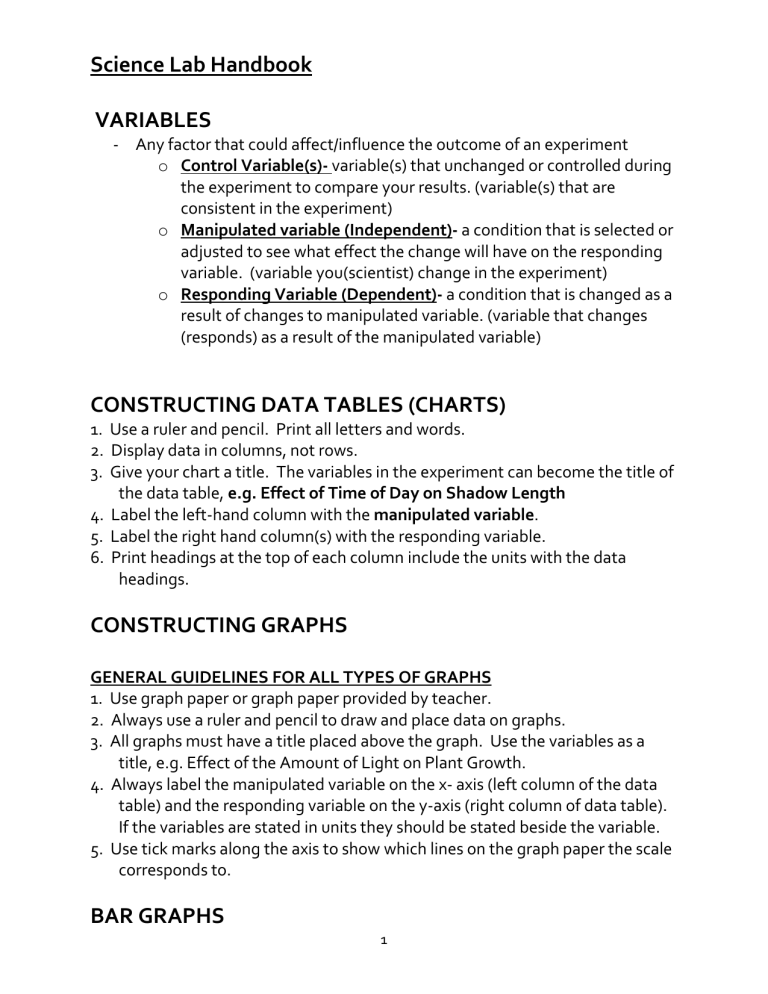
Science Lab Handbook VARIABLES - Any factor that could affect/influence the outcome of an experiment o Control Variable(s)- variable(s) that unchanged or controlled during the experiment to compare your results. (variable(s) that are consistent in the experiment) o Manipulated variable (Independent)- a condition that is selected or adjusted to see what effect the change will have on the responding variable. (variable you(scientist) change in the experiment) o Responding Variable (Dependent)- a condition that is changed as a result of changes to manipulated variable. (variable that changes (responds) as a result of the manipulated variable) CONSTRUCTING DATA TABLES (CHARTS) 1. Use a ruler and pencil. Print all letters and words. 2. Display data in columns, not rows. 3. Give your chart a title. The variables in the experiment can become the title of the data table, e.g. Effect of Time of Day on Shadow Length 4. Label the left-hand column with the manipulated variable. 5. Label the right hand column(s) with the responding variable. 6. Print headings at the top of each column include the units with the data headings. CONSTRUCTING GRAPHS GENERAL GUIDELINES FOR ALL TYPES OF GRAPHS 1. Use graph paper or graph paper provided by teacher. 2. Always use a ruler and pencil to draw and place data on graphs. 3. All graphs must have a title placed above the graph. Use the variables as a title, e.g. Effect of the Amount of Light on Plant Growth. 4. Always label the manipulated variable on the x- axis (left column of the data table) and the responding variable on the y-axis (right column of data table). If the variables are stated in units they should be stated beside the variable. 5. Use tick marks along the axis to show which lines on the graph paper the scale corresponds to. BAR GRAPHS 1 WHEN TO USE A BAR GRAPH When numerical values are associated with categories of places or things. STEPS FOR BAR GRAPH 1. Title the graph using the variables 2. Draw you x-axis and y-axis on the graph paper. x – category y – numerical value 3. Select an appropriate scale for the y-axis. 4. Decide on the width of the bars. 5. Draw a bar to represent the value. A space is left between each of the bars. 6. Color the bars. HISTOGRAM WHEN TO USE A HISTOGRAM A histogram is similar to a bar graph but there is no space between the bars. The histogram represents one continuous item. STEPS FOR HISTOGRAM 1. Follow the same steps for a bar graph but do not leave the space between the bars. LINE GRAPH WHEN TO USE A LINE GRAPH Line graphs make it easy to see a relationship between two sets of numbers. STEPS FOR LINE GRAPH 1. Title the graph using the variables 2. Draw you x-axis and y-axis on graph paper. 3. Label the axis. The x-axis (manipulated variable) is the horizontal line and the y-axis (responding variable) is the vertical line. 4. Decide upon a scale to use. Make sure the scale has regular intervals and has data fits onto the graph paper. Place scales on the axis and put tick marks to show the intervals. 5. Plot data on your graph with dots. 2 6. Draw a line to connect the dots on the graph. SCIENCE LAB WRITE UP PROCEDURE GENERAL RULES - All labs are to written neatly on a new sheet of loose-leaf paper. - All labs must have your name class and date in top right hand corner. - The lab can be written up in blue or black pen only. - Lab must have a margin down the left hand side to place the subtitles and heading in. - All lines must be draw with a ruler. LAB WRITETITLE UP FORMAT Activity number and title stated from the textbook 3 PROBLEM / QUESTION Write out as stated in textbook or create your own question if needed. VARIABLES Control Variable(s) – things that remain the same in each experiment. Manipulated Variable – the one factor that you change Responding Variable – changes as a result of the manipulated variable. HYPOTHESIS/ PREDICTION The hypothesis is an idea or explanation, based on previous observations and experience. Tells what you think will happen and gives a reason. MATERIALS/ APPARATUS As stated in the textbook. DIAGRAMS Draw diagrams in pencil. Label diagrams with parallel lines on the right hand side of the diagram with neat printing. Diagrams may also be done on a blank sheet and attached to the lab. PROCEDURE Procedures may be copied out of the textbook. Sometimes for lengthy procedure, teachers will give directions to condense it. OBSERVATIONS Data is recorded in pencil. ANALYSIS Questions from the textbook on lab maybe added to the lab write-up. CONCLUSION Must refer to hypothesis/problem and tell what you have learned from the lab. 4


